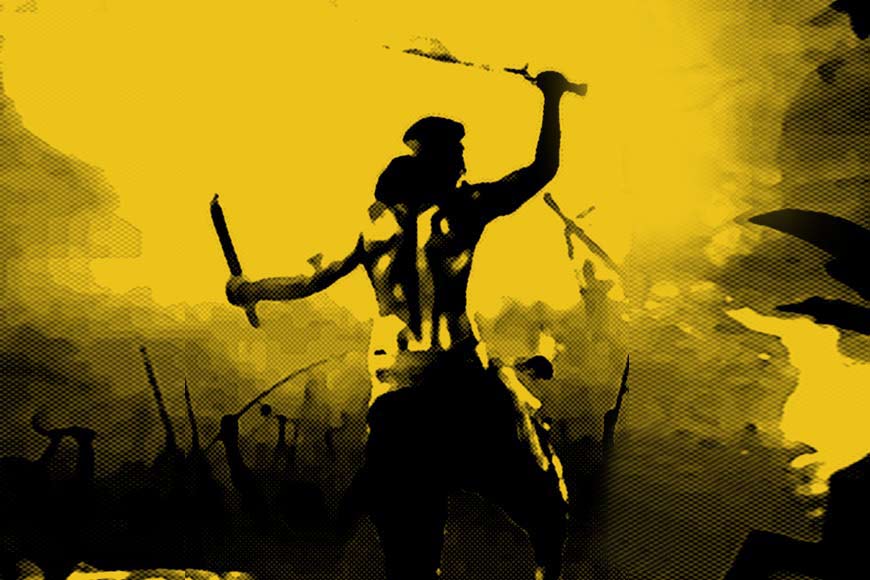‘Hare re re re’ – noble and ignoble Dacoits of Bengal

(In this 3-part series GB explores the tales of famous dacoits of Bengal in the 18th and 19th centuries, who were cult figures like Robin Hood! From Raghu, Bishe, Rana, Bede to Bhabani Pathak, the list is endless. But why did they take up banditry? Was it poverty or English indigo planters and their torture that forced them to turn dacoits? Here is an exclusive and exciting tale)
Remember Rabindranath Tagore’s famous poem, ‘Birpurush’ (The Valiant/ Hero)? The poem is about a child fantasizing saving his mother from dacoits. In the evening, when the sun sets, the child and his mother reach a barren place. He says, “We are cutting through the fields of bramble/ It’s nearly night, the beheras scramble/ The path curves out a little ahead,/ We are going over a dead riverbed/ In the plodding silence, you suddenly shout/ Are those lights out there, moving about?"/ Just then the cry, “Ha re re re re re." You can hear them charging; utter disarray/ Beheras running helter skelter/ You pray to heaven for divine shelter….” In the olden days, dacoits used to announce their arrival with the blood-curdling ‘Ha re re re’ cry that had an immobilizing effect on the victims.
Bengal in the 19th-century was no place for weaklings. Hot dusty winds rattled the palm leaves, mosquitoes buzzed, malaria, cholera, dysentery and smallpox struck down nearly half the debilitated white residents before their time. Many of the military who survived sickness were too often killed by saber gashes, or the surgeon’s amputation. This was also the time when dacoities aka banditry involving robbery by groups of armed bandits was rampant in the country. According to available official records, between 1841 and 1857, banditry was most rampant in Bengal especially in the districts of 24 Parganas, Barasat, Howrah, Hooghly, Burdwan, Nadia, Murshidabad, Jessore and Midnapur. The dacoity curve in 19th century Bengal reached its peak in 1851 with 524 recorded cases.
Also read : Madaris of Kolkata – the gypsy street magicians
In those days people went indoors as soon as the sun set and the day parted, making way for the evening. Villagers returned from work and huddled with their families within the four walls of the house as darkness descended. The gloomy world outside seemed an unfamiliar place, possessed by evil, nefarious elements of nature. If anyone noticed a flicker of light in the distance, locals would be at their wits’ end because it meant two things – either a supernatural occurrence or else, a band of outlaws were advancing towards the village. The sudden cry of "ha re re re re" tore apart the silence of the night with a blazing effect. However, most of these gang leaders hailed from poor families and had experienced misery and exploitation at the hands of the rich. So, they never harmed the hoi polloi. Their targets were always rich and cruel landlords who exploited the poor and compelled them to rigorous labor without proper compensations.
Rich landlords and villagers were always in awe of these armed robbers who would have the audacity to send a written note to their victims, specifying their day and time of arrival for looting. Tales of these infamous bandits of Bengal traveled distant places. Being few of the strongest, smartest and bravest men in the society, the robbers had scant sympathy or respect for the pompous gentry. Once the terror of the land and now legend, notorious dacoits like Raghu, Bishe, Rana and Bede have entered the realm of fables.
Popular literature tends to romanticize banditry in colonial Bengal as an element of popular protest or as a social aberration. In popular vernacular literature, dacoits have also been categorized into “noble” or ‘ignoble,” but it goes without saying that the bandits of Bengal were few of the most enigmatic personalities to have spread throughout the 18th , 19th and early 20th centuries.
Take for instance, Raghu Dakat and his daring escapades which have become so much a part of Bengali folklore that it is now next to impossible to sift the historical facts from the superhuman qualities attributed to the man and his expeditions. Some researchers have tried to take a sneak peek of Raghu behind the mythical trappings. According to most researchers, Raghu Ghosh was born in a poor peasant family approximately 200 years ago in the mid-18th century. This was the time when the East India Company initiated the commercial cultivation of indigo in Bengal. With the Nawabs of Bengal under East India Company rule, indigo planting became more and more commercially profitable because of the demand for blue dye in Europe. The indigo planters forced peasants to plant indigo instead of food crops on their own lands and resorted to mortgages or destruction of their property if they were unwilling to obey their orders. They even usurped land from the helpless farmers and then forced them to work in the indigo farms as bonded laborers.
Government rules favored the planters. By an act in 1833, the planters were granted a free hand to deal with the peasants. The zamindars who also stood to benefit from indigo cultivation, sided with the planters. Raghu’s father was one of the victims who was beaten to death by the local planter at his ‘Neelkuthi’ (office-cum-packaging unit and warehouse for indigo). Raghu, then barely in his teens, stood helpless and watched the perpetrators of tyranny murdering his father in cold blood. This was a big blow to him, and he vowed to avenge his father’s death. The ignominy drove him to take up arms.
(To be continued)










